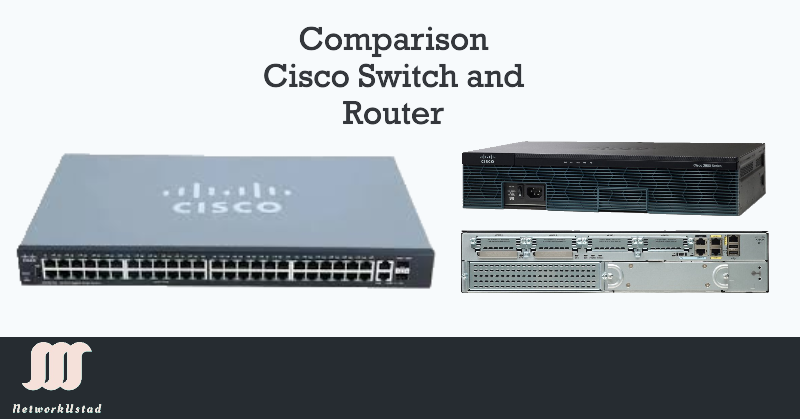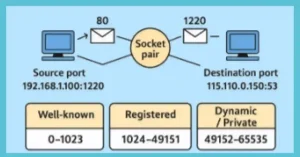The Switch and Router comparison is most important because both are the backbone devices in computer networking. So, I am comparing Switches and Routers for networking students. If someone understands the Switch and Router comparison, he can easily manage a network.
Definition of Router
A router is a Layer 3 (Network Layer) device that forwards data packets between distinct networks. Routers determine the optimal path for data transmission using a routing table and the destination IP address in packets. They operate with routable protocols like TCP/IP, which are essential for connecting local networks to the internet (WAN). Routers perform advanced functions such as Network Address Translation (NAT), Quality of Service (QoS), and firewall services.
Definition of Switch
A switch is primarily a Layer 2 (Data Link Layer) device that connects devices within a single network, using MAC addresses to forward frames. Layer 3 (multilayer switches) can route packets at Layer 3, combining switching and routing functionalities. Switches efficiently manage traffic within a LAN, reduce collision domains, and support features like VLANs for network segmentation.
Comparison: Switch and Router
| Aspect | Router | Switch |
|---|---|---|
| OSI Layer | Operates at Layer 3. | Layer 2 (traditional) or Layer 3 (multilayer). |
| Data Unit | Processes packets (IP addresses). | Forwards frames (MAC addresses) at Layer 2; Layer 3 switches handle packets. |
| Transmission Type | Unicast/multicast; no initial broadcast. | Begins with broadcast (e.g., ARP requests), then unicast/multicast. |
| Ports | Fewer ports (typically 2-8); modular WAN interfaces (e.g., fiber, DSL). | High port density (8/24/48 ports); modular options for scalability. |
| Network Scope | Connects LANs to WANs (e.g., internet). | Primarily used within a LAN. Layer 3 switches can route between VLANs. |
| Address Storage | Uses routing tables (IP addresses). | Uses CAM tables (MAC addresses) managed by ASICs. |
| Duplex Mode | Full-duplex exclusively. | Full-duplex (modern); older devices support half-duplex. |
| Broadcast Domains | Segments broadcast domains per port. | Single broadcast domain (unless using VLANs). |
| Collision Domains | Each port is a collision domain (rare due to full-duplex). | Each port is a collision domain (eliminated in full-duplex mode). |
| Key Functions | NAT, firewall, inter-network routing. | VLANs, traffic prioritization, MAC filtering. |
| Bandwidth Management | Dynamic allocation (QoS, traffic shaping). | Fixed port speeds (1/10/25/40/100 Gbps). |
| Speed | Varies by model; WAN interfaces may support high speeds. | High-speed LAN ports (1/10/40/100 Gbps). |
| NAT Support | Yes. | No (except Layer 3 switches with NAT capabilities). |
| Performance | Optimized for WAN routing with advanced features. | Layer 3 switches offer faster LAN routing via hardware ASICs. |
| Examples | Modern: Cisco ISR 1000/4000, Juniper MX Series. Legacy: Cisco 1900/2900. | Modern: Cisco Catalyst 9200/9500, Aruba 6300. Legacy: Catalyst 4500/6500. |
FAQs
- Which is the heart of the network in the switch and router: Router or Switch?
Both are critical. Routers connect networks (LAN to WAN), while switches manage intra-network device connectivity. - How do they handle data transmission?
Routers direct packets between networks using IP addresses. Switches use MAC addresses for frame forwarding (Layer 2) or packets (Layer 3). - Do routers start with broadcast transmission?
No. Routers use unicast/multicast based on routing tables. Switches broadcast initially (e.g., ARP) to learn MAC addresses. - Port flexibility?
Routers offer modular WAN ports (e.g., fiber). Switches provide high-density LAN ports (up to 48). - Typical deployment?
Routers: LAN-WAN boundaries. Switches: LAN core/access layers. Layer 3 switches handle intra-LAN routing. - Speed comparison?
Layer 3 switches outperform routers in LAN routing due to ASICs. Routers excel in WAN with advanced features. - NAT capability?
Routers perform NAT; traditional switches cannot. Some advanced Layer 3 switches support NAT.
Key Takeaways
- Routers are gateways between networks, using IP addresses and advanced protocols.
- Switches connect devices within a LAN, leveraging MAC addresses for efficient traffic management.
- Layer 3 switches bridge the gap, offering routing within LANs at hardware speeds.
Before going to the next lessons, take your self-assessment with our free quiz test using the following links
Quiz, 3 Basic Network Component CCNA (200-301)
Quiz Comparing Switch and Router – CCNA (200-301)





